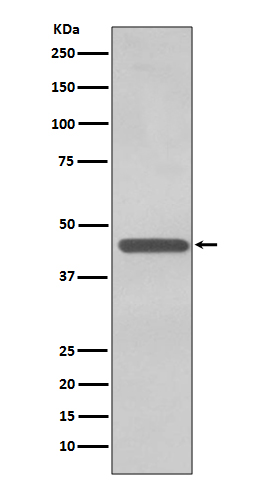
| WB | 咨询技术 | Human,Mouse,Rat,Zebrafish |
| IF | 1/20 | Human,Mouse,Rat,Zebrafish |
| IHC | 1/50-1/100 | Human,Mouse,Rat,Zebrafish |
| ICC | 1/50-1/200 | Human,Mouse,Rat,Zebrafish |
| FCM | 1/50-1/100 | Human,Mouse,Rat,Zebrafish |
| Elisa | 咨询技术 | Human,Mouse,Rat,Zebrafish |
| Aliases | ALS10; TDP-43 |
| Entrez GeneID | 23435 |
| WB Predicted band size | Calculated MW: 45 kDa; Observed MW: 45 kDa |
| Host/Isotype | Rabbit IgG |
| Antibody Type | Primary antibody |
| Storage | Store at 4°C short term. Aliquot and store at -20°C long term. Avoid freeze/thaw cycles. |
| Species Reactivity | Human,Mouse,Rat,Zebrafish |
| Immunogen | A synthesized peptide derived from human TDP43 |
| Formulation | Purified antibody in PBS with 0.05% sodium azide. |
+ +
以下是关于TDP-43抗体的3篇参考文献(包含作者、文献名称及摘要内容):
---
1. **文献名称**:*Ubiquitinated TDP-43 in frontotemporal lobar degeneration and amyotrophic lateral sclerosis*
**作者**:Neumann M, et al. (2006)
**摘要**:该研究首次发现TDP-43是额颳叶痴呆(FTLD)和肌萎缩侧索硬化症(ALS)患者脑内泛素化包涵体的主要成分,揭示了TDP-43蛋白异常聚集与神经退行性疾病的直接关联,为后续抗体开发提供了病理学基础。
---
2. **文献名称**:*Phosphorylated TDP-43 in frontotemporal lobar degeneration and ALS*
**作者**:Hasegawa M, et al. (2008)
**摘要**:研究开发了针对磷酸化TDP-43的特异性抗体,证实其在FTLD和ALS患者病理样本中可选择性标记异常磷酸化的TDP-43包涵体,为区分病理性与正常TDP-43提供了重要工具。
---
3. **文献名称**:*Antibody-based profiling of TDP-43 phosphorylation reveals divergent patterns in FTLD-TDP and ALS*
**作者**:Zhang YJ, et al. (2019)
**摘要**:通过多种TDP-43抗体系统分析不同疾病亚型中TDP-43的磷酸化状态和亚细胞定位,揭示了FTLD与ALS患者间TDP-43病理特征的差异,强调了抗体选择对病理诊断的重要性。
---
**注**:以上文献均聚焦于TDP-43抗体的开发、验证及其在神经退行性疾病研究中的应用,涵盖病理机制探索和诊断工具优化方向。
TDP-43 (TAR DNA-binding protein 43) is a ubiquitously expressed RNA-binding protein involved in regulating RNA metabolism, including splicing, transport, and stability. Under physiological conditions, it predominantly localizes to the nucleus, but pathological cytoplasmic aggregation of TDP-43 is a hallmark of several neurodegenerative diseases, such as amyotrophic lateral sclerosis (ALS) and frontotemporal lobar degeneration (FTLD). These abnormal aggregates are characterized by hyperphosphorylation, ubiquitination, and fragmentation of TDP-43.
Antibodies targeting TDP-43 are critical tools for studying its role in both normal cellular functions and disease mechanisms. Commonly used antibodies recognize specific epitopes, such as the C-terminal region (implicated in pathological modifications) or phosphorylated residues (e.g., Ser409/410), enabling the detection of disease-associated isoforms. Researchers employ these antibodies in techniques like immunohistochemistry, Western blotting, and immunofluorescence to visualize TDP-43 mislocalization, quantify expression levels, and analyze post-translational modifications in patient tissues or experimental models.
The development and validation of TDP-43 antibodies have advanced diagnostic accuracy and mechanistic insights into TDP-43 proteinopathies. However, challenges remain, including cross-reactivity with related proteins or fragmented TDP-43 species. Ongoing efforts focus on improving antibody specificity to distinguish between physiological and pathological forms, aiding both basic research and clinical diagnostics.
×